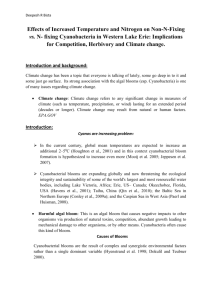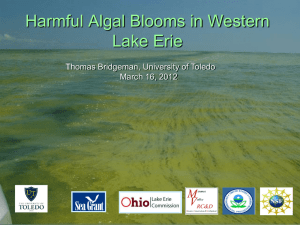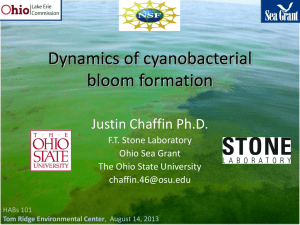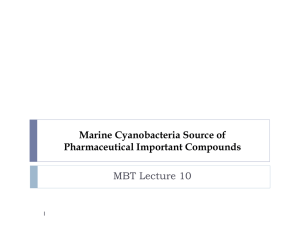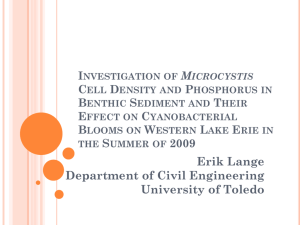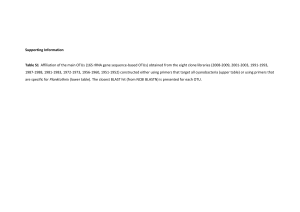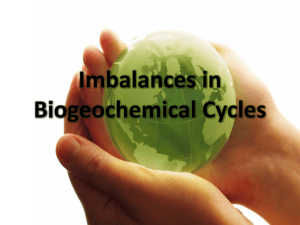Effects of Increased Temperature and Nitrogen on Non-N
advertisement
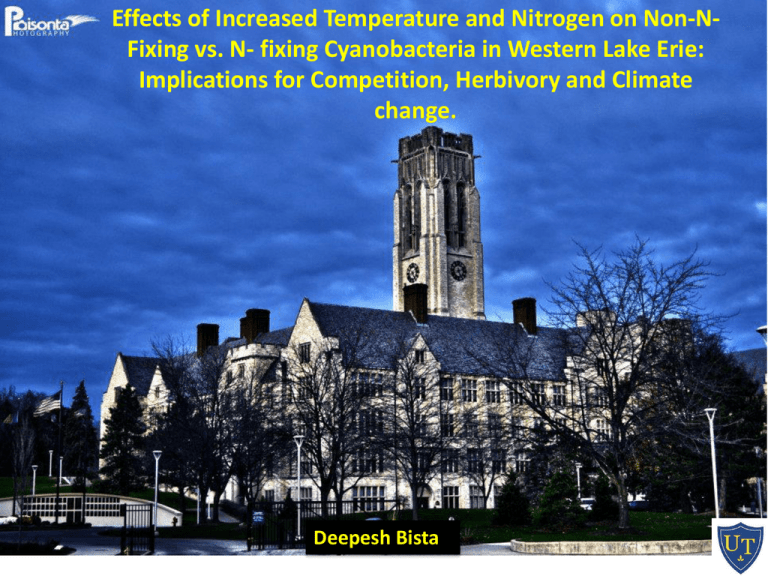
Effects of Increased Temperature and Nitrogen on Non-NFixing vs. N- fixing Cyanobacteria in Western Lake Erie: Implications for Competition, Herbivory and Climate change. Deepesh Bista Introduction: What is climate change? • http://www.cpdcngo.org/rubrique.php3? id_rubrique=38 Climate change refers to any significant change in measures of climate (such as temperature, precipitation, or wind) lasting for an extended period (decades or longer). Climate change may result from natural or human factors. What are Cyanobacteria? • “Blue-green algae” • Having a pigment called chlorophyll. • Unlike most plants and Eukaryotic algae, many cyanobacteria are able to use (or fix) nitrogen from the atmosphere using specialized cells called heterocysts. • Cyanobacteria can be distributed throughout the water or they can float to form scums on or near the surface. http://www.glc.org/announce/11/pdf/Bridgeman-UToledo.pdf Harmful: produce toxins Algal: planktonic, photosynthetic Bloom: high concentration of cells, often at surface Degrades water quality • Taste/odor issues. • Loss of recreational and fishing value to affected water (spot fish recruitment ($1B fishery). • Hypoxia/anoxia, may lead to mortality in benthic invertebrate community and fish kills. Alters food webs • Unpalatable to many zooplankton grazers. Toxin producer • Toxic to zooplankton, shellfish, fish, animals, humans. (neurotoxins, hepatotoxins , dermatotoxins) http://www.facebook.com/photo.php?fbid=10150279634809211&set=a.10150279634754211.339931.95001469210&type=1&theater Why Should WE care about Harmful Algal Blooms (HAB’s)? Great Lakes: • • • • • Largest supply of freshwater in the world. 80% of US freshwater supply. Drinking water supply for 40 million US and Canadian citizens. Used extensively for recreation. City of Toledo spends $3-4K/day in water treatment during bloom. In United States, CyanoHAB’s result in losses of recreational, drinking, and agricultural water resources worth $2 billion annually (2009). Climate Change Cyanobacteria ? • Global mean temperatures are expected to increase an additional 2–50C . • So are the cyanobacterial blooms. • Cyanobacterial blooms are expanding globally and now threatening the ecological integrity and sustainability of some of the world's largest and most important fresh water bodies, including Lake Victoria, Africa; Erie, US-Canada; Okeechobee, Florida, USA Taihu, China. Microcystis in Lake Erie 35,001 mL/m2/y Microcystis- Anabaena bloom of 2009 was the largest in recent years in our sampling region until 2011……… 2011 http://www.glc.org/announce/11/pdf/Bridgeman-UToledo.pdf Causes of Blooms • Result of complex and synergistic environmental factors rather than a single dominant variable. http://cws.msu.edu/documents/Dyble_post_000.pdf Past Studies: Temperature: • As temperature increased, the algal group with the highest growth rate changed from diatoms to green algae to blue-green algae (cyanobacteria). • Increased temperature increases cyanobacterial blooms because of increased water temperature, the longer period of thermal stratification, and increased internal nutrient loads. Nutrients: • Even though phosphorus (P) is assumed to be the limiting nutrient, nitrogen (N) may be equally important in the occurrence of toxic non N-fixing cyanobacteria blooms, such as Microcystis sp. • Laboratory studies have indicated that increasing N loads increase the growth and toxicity of this species . • Laboratory research suggests toxic strains of Microcystis are able to outgrow non-toxic strains at high nitrogen levels. http://cws.msu.edu/documents/Dyble_post_000.pdf http://cws.msu.edu/documents/Dyble_post_000.pdf What Does Existing Literature Say? So, What’s New then???????? None to our knowledge have shown the relationship of the increase Temperature and Nitrogen level to toxin production and then its effect on the zooplankton (herbivory) and the competition between the N-fixers and non- N-fixing cyanobacteria. Nitrogen Fixation: Conversion of atmospheric nitrogen gas into organic nitrogen or to form, readily utilized in biological processes useful to plants and other organisms by lightning, bacterial-induced nodules, and blue-green algae. This is part of the nitrogen cycle. Microcystis Anabaena http://www.glc.org/announce/11/pdf/Bridgeman-UToledo.pdf In most summers, we get a bloom of non-Nfixing Microcystis and a second bloom of a nitrogen-fixing species (either Anabaena or Aphanizomenon) under low N conditions in late summer. • If in the future temperature and nitrogen increase, then what will happen to this succession of bacterial blooms? • How much the competition will have its say and what does the community looks like? Nitrogen loading and concentration drop during the summer leading nitrogen limited conditions. Aim: 1. Investigate how increase in water temperature and N, individually and in combination, affect the growth, toxicity and herbivore food quality of important nonN fixing and N-fixing Lake Erie CyanoHABs. 2. Determine how water temperature and N affect competition between important non-N-fixing and N-fixing Lake Erie CyanoHABs. 3. Determine how water temperature and N affect herbivory of important non-N-fixing and N-fixing Lake Erie CyanoHABs. 4. Using 1-3 results I will try to generate a model to predict effect of temperature and N on CyanoHABs in Lake Erie, including relative success of non-N-fixing and N-fixing CyanoHABs in the future, when lake temperature are warmer, growing seasons are longer and N levels are likely to be higher. 20oC For low levels 25oC When the lake is heated up 30oC What if the Temp. really increases?? Nitrogen Western part of Lake Erie in Toledo. 1. Close to the Canadian border, influenced by the Detroit River. 2. On the mouth of the Maumee. 3. Influenced by the Maumee but off the bay. Lake Community: 3 levels of Temperature X 4 levels of Nitrogen. 10 days in growth chamber. Chlorophyll as means of biomass and growth. Assay Toxicity- Herbivore, Algae. Assay food quality- Total Protein, Lipid ,and NSC-CHO. Count- Herbivore, CyanoHAB’s like Microcystis . To be analyzed in winter Sample 2 Sample 1 1 Aug 26 2 Sept 14 3 Spet 29 4 Oct 13 Sample 4 Sample 3 Temperature oC Step two: Ordering the isolated samples of the cyanobacteria (Anabaena and Microcystis) U Texas. Cultured at same level of nitrogen and temperature. Analysed competition between the N-fixing and non N fixing species. Toxicity, herbivory and growth. In the second phase, the herbivore (i.e. Daphnia) will be introduced and then will be grown with algae to determine effects of herbivores? This helps me in: Achieving my 3rd objective regarding what happens to the lake as a community if Temp and N level does increase and who wins who loses(i.e. competition between the species). References • Tillmanns, Angeline R.; Wilson, Alan E.; Pick, Frances R.; Sarnelle, Orlando (2008) Meta-analysis of cyanobacterial effects on zooplankton population growth rate: species-specific responses. Fundamental and Applied Limnology 171: 285-295. • Claska ME, Gilbert JJ (1998). The effect of temperature on the response of Daphnia to toxic cyanobacteria. Freshw Biol 39:221–232. • Davis, T. W. and C. J. Gobler (2011). "Grazing by mesozooplankton and microzooplankton on toxic and non-toxic strains of Microcystis in the Transquaking River, a tributary of Chesapeake Bay." Journal of Plankton Research 33(3): 415-430. • Song L.; Sano, T.; Li, R.; Makoto, W.M.; Liu, Y.D.; Kaya. K.; (1998). Microcystin production of Microcystis viridis (cyanobacteria) under different culture conditions. (1998). Phycology Research, 42:19–23. • Timothy W. Davis, Dianna L. Berry, Gregory L. Boyer, Christopher J. Gobler (2009). The effects of temperature and nutrients on the growth and dynamics of toxic and non-toxic strains of Microcystis during cyanobacteria blooms. Harmful Algae 8:715-725. http://cws.msu.edu/documents/Dyble_post_000.pdf धन्यबाद् THANK YOU!!!
